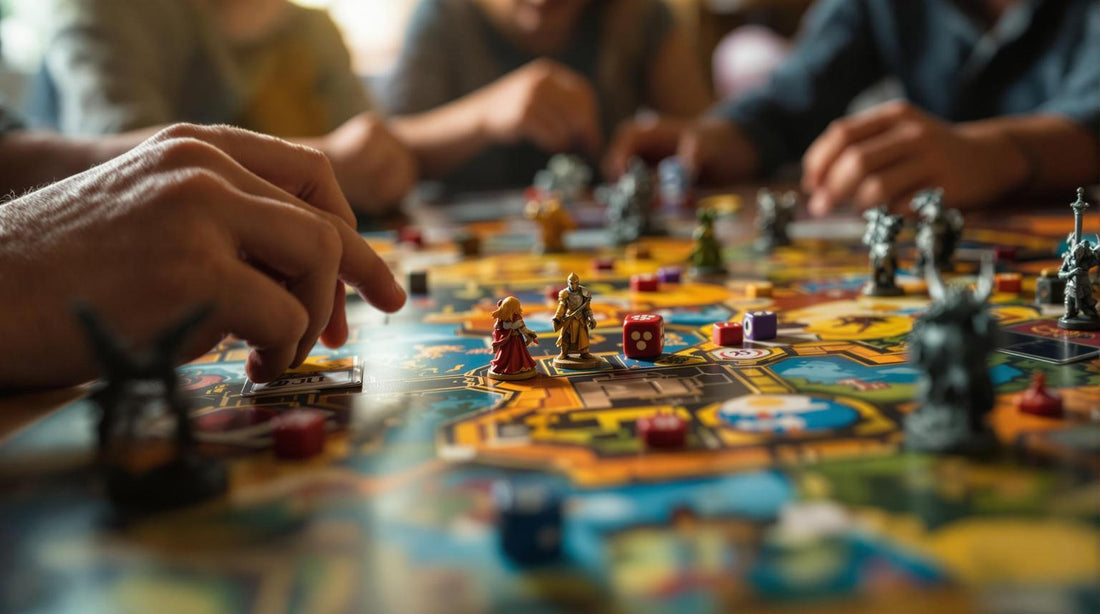Discover the Best Board Games for Every Player

Ultimate Guide to Endgame Strategy Development
Endgame strategy is the deciding factor in many board games. Mastering it can help you secure draws, convert small leads into wins, and make better decisions with limited resources. Here’s a quick summary of the key takeaways:
- Core Principles: Centralize your king, create passed pawns, and exchange pieces wisely.
- Winning Methods: Assess your position regularly, optimize resources, and stay flexible.
- Common Mistakes: Avoid calculation errors, stalemate oversights, and misjudging positions.
- Practice Plan: Start with basic techniques (e.g., checkmates), then move to complex scenarios like pawn endings and grandmaster-level analysis.
Endgame mastery requires consistent practice and understanding of these principles to turn theoretical knowledge into practical wins.
Related video from YouTube
Main Endgame Rules
Learn the key principles that shape successful endgame strategies in board games.
Basic Endgame Rules
One of the most important principles in endgame play is: "Do not hurry". Take time to strengthen your position before making decisive moves.
When analyzing endgame positions, focus on these critical elements:
| Element | Strategic Focus | Impact |
|---|---|---|
| King Position | Centralize the king | Increases control and supports other pieces |
| Piece Exchange | Evaluate long-term outcomes | Creates advantageous imbalances |
| Pawn Structure | Prioritize passed pawns | Provides winning opportunities |
| Resource Balance | Compare material and position | Guides the best path to victory |
These principles lay the groundwork for a methodical approach to winning.
Standard Winning Methods
Building on the basics, winning endgames requires applying steady pressure and managing resources effectively.
Key strategies include:
- Position Assessment: Regularly evaluate your standing against opponents, using victory points or other benchmarks.
- Resource Optimization: Turn your resources into decisive advantages on the board.
- Tactical Flexibility: Adjust your strategy as the game evolves.
"As a designer I want to guide my players to do the things that will make the game enjoyable. The best way to do this is by incentivizing certain behavior." - Bastiaan
Major Mistakes to Avoid
Avoiding common mistakes is just as important as applying the right strategies. A notable example is Ivan Veselov's May 2023 game, where a misjudged pawn capture (bxa4) resulted in a lost position.
Watch out for these pitfalls:
- Calculation Errors: Always double-check your instincts with precise calculations.
- Stalemate Oversights: Recognize stalemate as a potential defensive tool for your opponent.
- Position Misjudgment: Reevaluate your approach after major shifts in the game.
"Trust but verify, i.e. it's always good to check your instincts with the calculation." - Ivan Veselov
Mastering the endgame is about combining theory with practice and avoiding rash decisions. For hands-on experience, consider exploring strategic board games from retailers like Brain Games.
sbb-itb-1ed942f
Expert Endgame Methods
Mastering endgame techniques builds on fundamental principles, helping you turn small advantages into victories.
Resource Control
Controlling resources in the endgame requires careful placement and use of your pieces. A key idea is to pressure your opponent's weak pawns while protecting your own. Here's a breakdown of important resource types, their strategic roles, and effective tactics:
| Resource Type | Strategic Role | Key Tactics |
|---|---|---|
| Heavy Pieces | Dominate open files | Break into the opponent's camp |
| King | Play an active role | Target weak pawns or key squares |
| Pawns | Advance toward promotion | Create passed pawns |
| Minor Pieces | Exploit weak squares | Set up outposts in enemy territory |
Piece Tactics
Endgame tactics are different from those in the middlegame. While tactical chances are fewer, they remain essential for achieving your strategic goals.
Key tactics to focus on include:
- King Activation: Move your king actively toward weak pawns. If no weak pawns are available, aim for control of central squares.
- Heavy Piece Control: Use rooks and queens to dominate open files and create threats.
- Pawn Structure: Take advantage of weak enemy pawns to create game-changing targets.
These tactics pave the way for flexible play as the board evolves.
Responding to Changes
Adjusting to changes on the board is critical in the endgame. Exchanges often shift the balance, creating new opportunities or challenges. To stay ahead:
- Reevaluate the board after every exchange to spot new tactical possibilities.
- Keep your pieces coordinated and ready to adapt to structural changes.
- Simplify the position through calculated exchanges when it strengthens your position.
A classic example comes from the game Cohn E. vs. Rubinstein A. (1909). Rubinstein's winning approach involved activating his king toward a weak h2 pawn, showing the importance of targeting specific weaknesses over general centralization.
Real Game Examples
Using advanced endgame techniques in real matches shows how they can turn the tide.
Game Analysis
Let’s break down some notable endgame scenarios from competitive play. In a Kotov vs. Pachman chess match, White capitalized on two weak points: Black's c6-pawn and h7-square. By applying pressure to both, White gained control of the e5-square and secured the win.
In Scrabble tournaments, the endgame kicks in when fewer than seven tiles remain in the bag. This phase often determines the final outcome as players manage limited resources and scoring opportunities.
Common Endgame Situations
Each game presents its own set of endgame hurdles, requiring tailored strategies:
| Game | Common Situation | Winning Strategy |
|---|---|---|
| Chess | King and Pawn vs King | Move your king toward opposition |
| Catan | Race to 10 points | Focus on hexes with high-probability rolls |
| Scrabble | Last 7 tiles phase | Track remaining letters and control key squares |
For example, in Catan, starting settlements give players two Victory Points. To win, they must gather eight more through resource collection, development cards, and strategic placement. This initial lead influences how players approach the final stages of the game, balancing risk and reward.
Games for Practice
Want to sharpen your endgame? Try games from Brain Games. Chess variants help refine core tactics, while resource-heavy games like Catan hone your ability to make tough decisions under pressure.
Expert Ashton Wu offers this advice for Catan:
"Sharpen your Catan strategy by making strategic trades. Avoid making deals that primarily benefit your opponents, as each resource you give them brings them closer to winning. Instead, wait for fair trades that can benefit both parties (especially you). Trading is key to conquering Catan, but be patient."
Conclusion
Main Points
Mastering endgame strategy hinges on understanding key principles and consistent practice. As GM Khachiyan puts it, "thinking from the end" is what sets masters apart from amateurs. Using the concept of two weaknesses - like managing passed pawns while targeting weak squares - can help crack even the toughest defenses. And don't underestimate the importance of the king's role. Nimzowitsch famously noted:
"In the Middlegame the King is a mere extra, but in the Endgame he is a principal"
These ideas lay the groundwork for turning theoretical knowledge into practical skills.
Practice Plan
Here’s a focused approach to sharpen your endgame skills:
| Skill Level | Focus Area | Practice Method |
|---|---|---|
| Beginner | Basic Checkmates | Practice key mates with queen, rook, and bishops |
| Intermediate | Technical Positions | Work on king and pawn endings, and rook endings with multiple pawns |
| Advanced | Complex Scenarios | Analyze grandmaster games and practice converting material advantages |
"Endgames are the most challenging part of chess. Just one wrong move, and the outcome of the game can be irreversible. And somehow, it's the part of the game that chess players study the least. That's why endgame mastery will give you a substantial advantage over your competitors"
To improve, focus on solving endgame puzzles that emphasize theoretical positions over tactical ones. Tools like Brain Games can also help develop strategic thinking across various scenarios. Regularly practicing fundamental positions in real game settings is key to building true endgame expertise.






